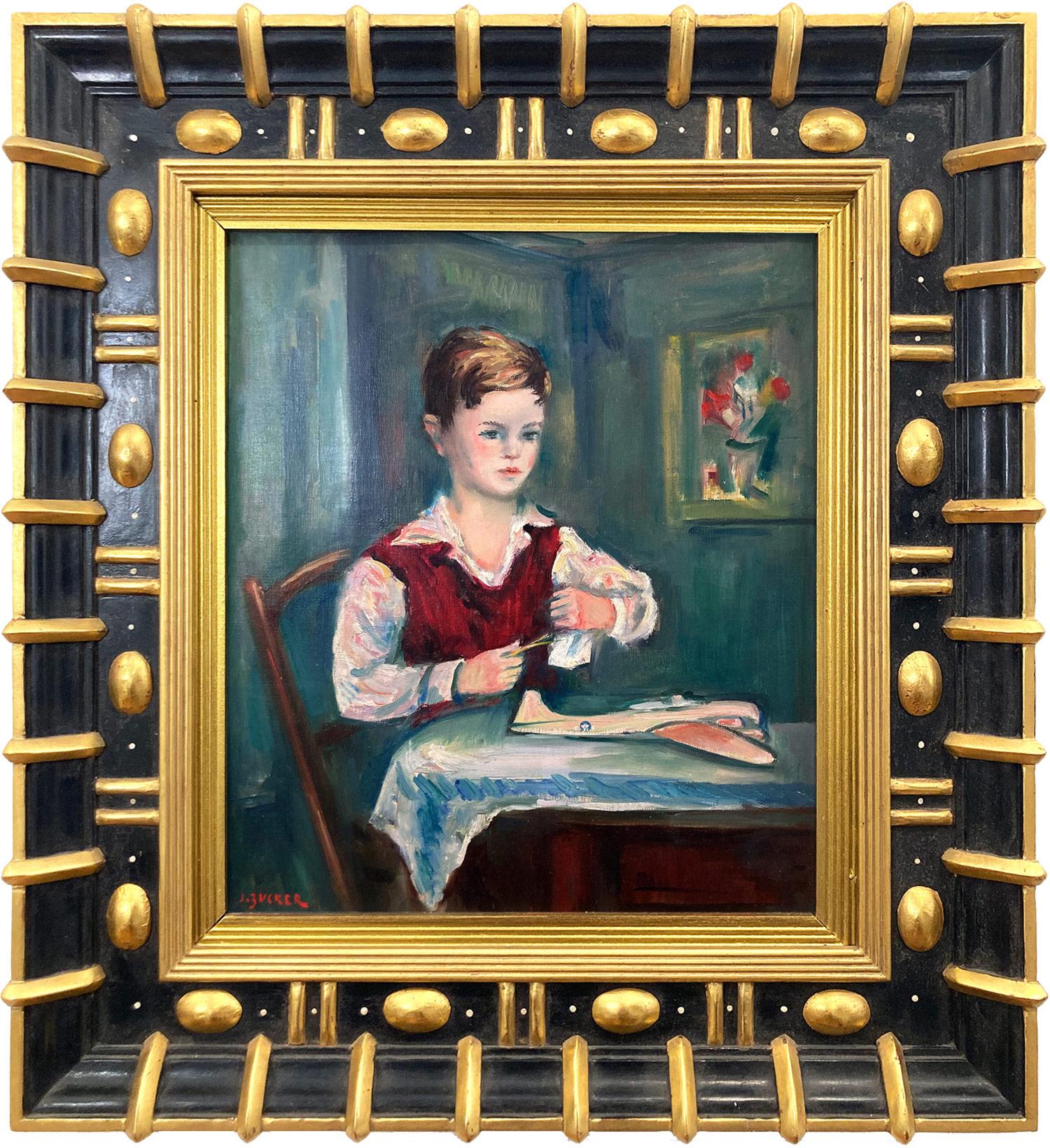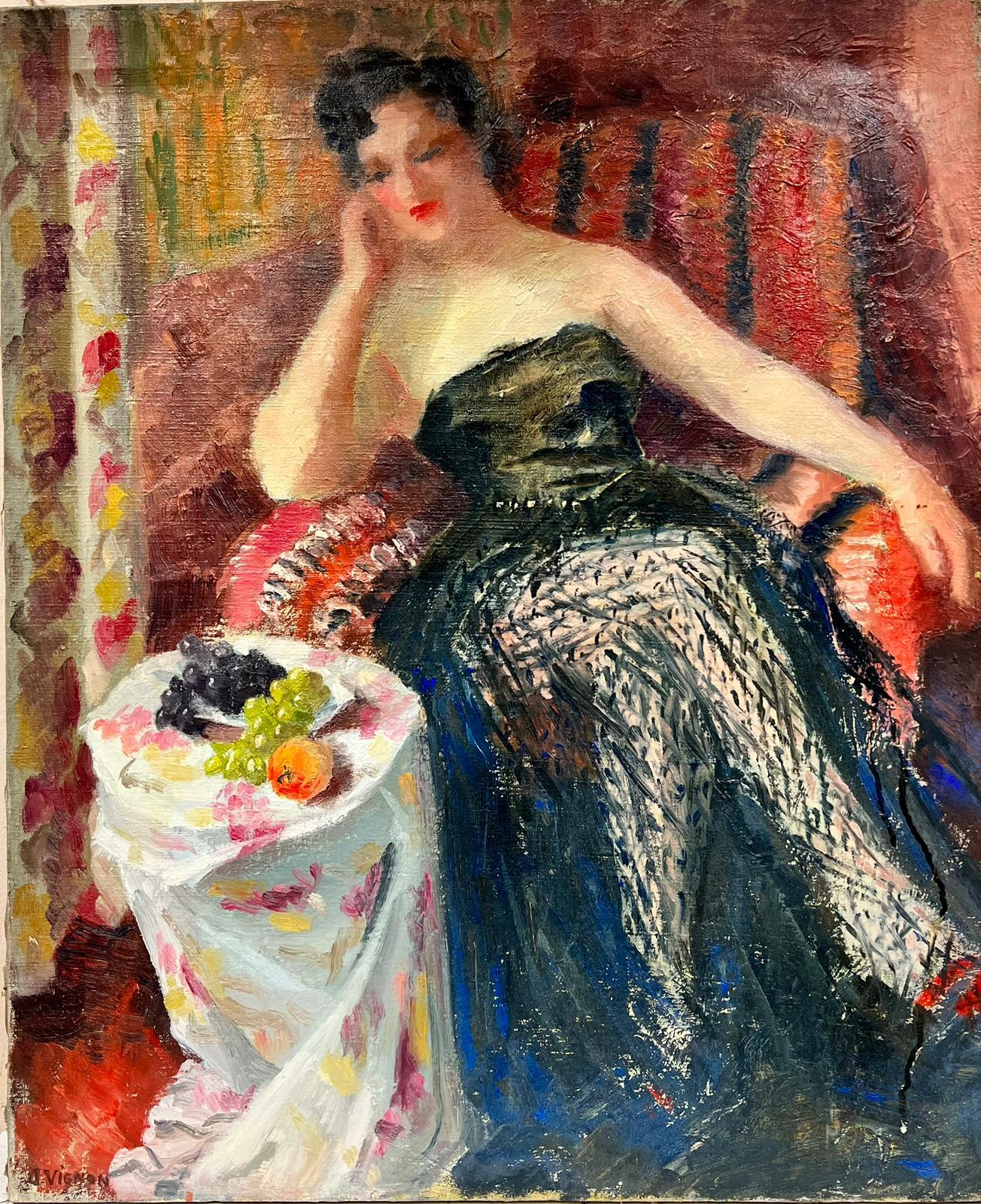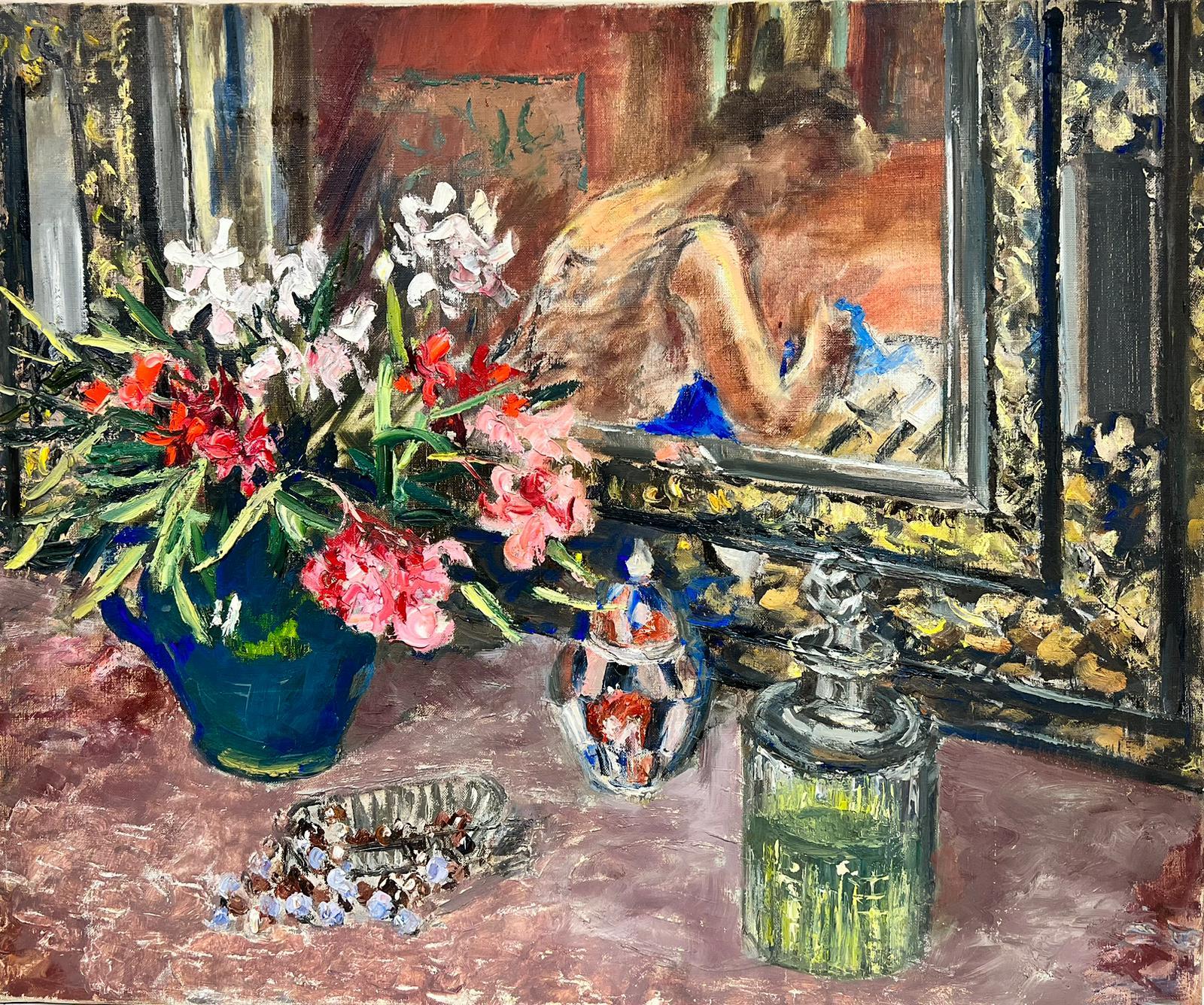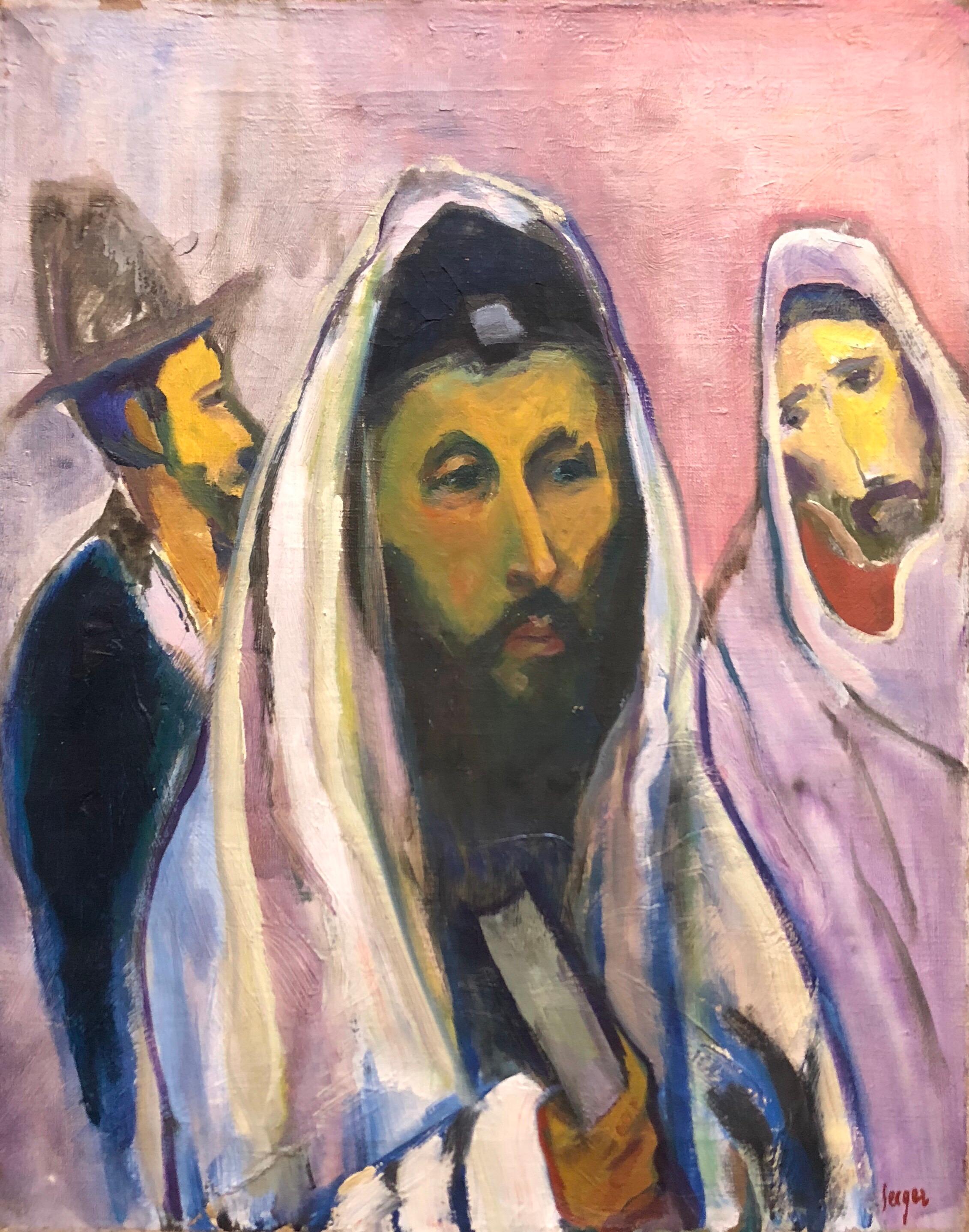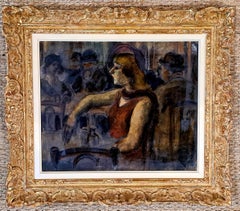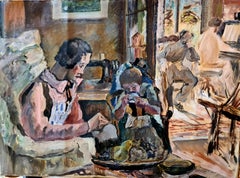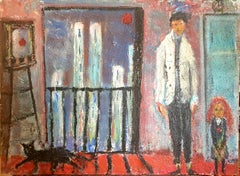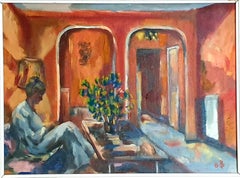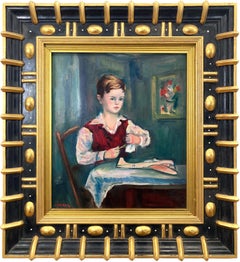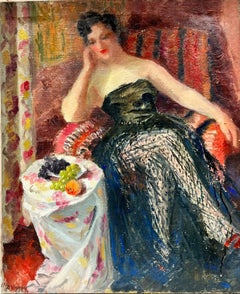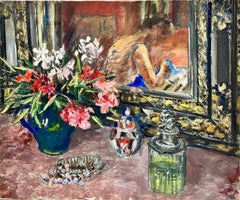Articles similaires à Ecole de Paris, Post Impressionist Portrait of a Mother and Child
Chargement de la vidéo
Vous voulez plus d'images ou de vidéos ?
Demander au vendeur plus d'images ou de vidéos
1 sur 23
Pere Modesto Luis CreixamsEcole de Paris, Post Impressionist Portrait of a Mother and Child1950s
1950s
À propos de cet article
Mid 20th Century oil on canvas portrait of a mother and child by the noted Franco Spanish artist Pere Modesto Luis Creixams. The painting is signed bottom left and presented in a very fine patinated wood frame.
This vibrant painting portrays an intimate moment between a mother and her child, capturing the depth of their bond. Creixams employs a dynamic palette of blues, greens, and warm earthy tones, creating a harmonious contrast that emphasizes the tenderness of their connection. The mother, clad in a vivid, multi-hued garment, appears to be in motion, her gentle gaze focused intently on the child cradled in her arms. The child, painted with delicate brushstrokes, mirrors her affectionate expression. The background features abstract floral and geometric shapes, adding depth and complexity. The expressive use of brushwork and colour conveys emotion, movement, and warmth. This painting stands as a timeless celebration of maternal love and the nuances of human emotion. Its captivating composition invites viewers to engage with the serene yet dynamic energy of the scene.
Pere Créixams (9 November 1893 – 1965) was a Spanish painter and illustrator.
A figurative and self-taught painter, his work reflects both the sources of the School of Paris and Catalan painting. Throughout his life, he divided his time, between Spain, his native country, and France, his adopted country.
Pere Créixams began his studies at the Escuela Moderna (the Modern School).
He travelled in 1917 to Paris, in Montparnasse. He made his debut with François Bernouard, at La Belle Édition in 1917. The meeting with the writer Florent Fels was decisive. He introduced him to all of intellectual Paris: the poet, art critic and writer André Salmon who nicknamed him Pierre the Printer, the Swiss writer Blaise Cendrars, Max Jacob, André Malraux, Raymond Radiguet, André Salmon and the painter Amedeo Modigliani.
Creixams continued his art under the advice of the painter Othon Friesz and it was the time of his first successes. He exhibited in 1921 at the Café du Parnasse and at the Galerie Montaigne in Paris. His portraits of women are marked by the style of the illustrious representative of the School of Paris, Amedeo Modigliani.
Florent Fels introduced him to the famous Parisian art dealer Paul Guillaume, who was located at 39, rue La Boétie. The latter offered to sign a contract to commit to delivering all his artistic production to him from November 1921 to June 1922. Creixams' paintings are exhibited alongside those of André Derain, Pablo Picasso, Maurice de Vlaminck, Henri Matisse and Amedeo Modigliani...
Subsequently, Creixams worked with the gallery owner Pierre Loeb with whom he signed a contract in 1925. Located at the corner of Rue de Seine and Rue des Beaux-Arts, the famous Pierre Gallery which, from 1927 to 1963, represented many artists who marked the twentieth century (Braque, Klee, Chirico, Derain, Dufy, Gromaire, Léger, Miro, Pascin, Picasso, Soutine, Masson, Man Ray...)
In painting, he turned to his Spanish ancestors, El Greco, Francisco de Goya, Diego Velázquez in order to affirm their artistic heritage. His admiration for Pablo Picasso was also felt in his production of the 1920s and he learned the lesson of the painter of the poor, the acrobats and the guitarists.
From 1922, he settled in Montmartre and frequented the former members of the Bateau-Lavoir such as Pablo Picasso, Max Jacob, André Salmon. His friends in Florent Fels' literary circle supported him and Creixams then became friends with writers. The painter became an illustrator and collaborated with the writer and publisher duo Pascal Pia and René Bonnel on the unpublished poem by Charles Baudelaire, published from the original manuscript, which he adorned with eight etchings.
In 1928, he exhibited at the Salon d'Automne and also took part in the Salon des Indépendants and the Salon des Tuileries.
Creixams made a name for itself by exhibiting in Parisian galleries and salons. (Salon des Indépendants, Salon d'Automne, Salon des Tuileries). In Paris, he befriended Catalan artists, like him exiled, or staying in the French capital, such as Joaquín Torres García, Eugenio d'Ors and Joan Miró. In Barcelona, in the same way, Creixams maintained friendships. His meeting with the critic and painter Rafael Benet opened the doors to the Barcelona artistic world. Creixams was a total success: he was presented in the city's avant-garde galleries, in salons and his works attracted the eye of collectors (Galeríe Dalmau, Sala Parés, Syra Art Galleries). He exhibits his works regularly at the Exposició de Primavera [Spring Exhibition], Saló de Montjuïc.
Creixams' painting was first inspired by the Catalan noucentista. This movement, which began around 1906 and lasted until the beginning of the civil war in 1936, was artistic and political and proposed a renewal of society. Eugenio d'Ors, the theoretician of this new aesthetic, wanted an artistic regeneration in Catalonia. Then Creixams quickly evolved towards a popular and direct realism claimed by the new generation of artists called Generació del 17. His landscapes are very constructed, geometrized, the result of a great admiration for Paul Cézanne.
Creixams' attachment to his country was manifested in regular visits to Catalonia throughout his life. The summer period was privileged and the small fishing village of Tossa de Mar welcomed the artist during many stays. These returns to Catalonia bring Creixams a new inspiration and a more personal style. Tossa, a haven of peace and a site of great beauty, became a real artistic and intellectual centre under his leadership. Creixams and Benet brought with them their Catalan friends: Emili Bosch Roger, Francesc Camps Ribera, Josep Gausachs, Francesc Domingo, Josep Mompou, Manuel Humbert, Emili Grau Sala, Enric Casanovas. But the attraction went beyond the Catalan borders thanks to the knowledge of the artist who invited his Parisian friends, writers, led by Florent Fels, Georges Charensol, Georges Duthuit and artists such as Albert Marquet, Roger Wild, Georges Kars and Marc Chagall.
After spending the summer of 1934 in Tossa in the company of many artists, Creixams did not return to Paris and remained in Catalonia until 1937. In fact, he was appointed professor at the Escola Superior de Paisatge d'Olot. Then came the year 1937, marking a historical and political turning point for Catalonia and Spain. Creixams is artistically committed to the Republicans. It was at that time that the Catalan government chose him to illustrate a propaganda work published by the Commissariat de Propaganda de la Generalitat.
He experienced the first armed clashes in Barcelona, but finally, as the situation deteriorated, he returned to live in Paris on February 20, 1937. He left Catalonia in the middle of the civil war and only returned after an eleven-year exile. Following his committed drawings, in 1939 he produced canvases illustrating the Retirada depicting the flight to France of thousands of Spanish Republicans.
This return to France, during the Second World War, and the period of the Occupation were difficult. But Montmartre once again welcomed him with open arms and Creixams met up with his friends from the Butte, writers, painters and songwriters. He then became an essential figure in Montmartre alongside Marcel Aymé, Pierre Mac-Orlan, Gen Paul among others. The traditional party atmosphere that reigns in Montmartre suits the bon vivant character of Creixams perfectly. The distance from his native country for several years resulted in a painting with deep Spanish accents.
Creixams,in 1938, again participated in the various Parisian salons. In addition, he exhibits as a Montmartre artist in group exhibitions but also alongside his Catalan compatriots. Regular solo exhibitions are devoted to him by Parisian galleries. (Delpierre Gallery, Petridès Gallery, Élysée Gallery, Charpentier Gallery...)
Around 1940, Creixams met Nana de Herrera (1905-1991) and from their love was born a child, Ramon de Herrera. Nana de Herrera, a major figure in Parisian social life during the Roaring Twenties, is a Spanish classical ballet dancer. She was the model for Max Ponty for his design of the famous Gitanes cigarette packet (from the Seita). She also played a few film roles, both before and after the war. It is famous, among other things, for the portrait made by Tamara de Lempicka in 1928 at the request of the Austro-Hungarian Baron Raoul Kuffner. A distant echo of Joël Martel's advertisement that depicted her in a dance posture in 1926, Lempicka's painting seems to have been made to emphasize her personality.
Creixams began a career as a society portraitist in the 1940s. He frequented the world of theatre and cinema. His favourite subjects are evocations of Spain. Gypsies, majas, dancers, bullfighters evolve between reality and fantasy. During the Occupation, Creixams frequented the Lapin Agile with the painter Gen Paul at 4, rue des Saules and the restaurants Chez Manière, rue Caulaincourt and Chez Pomme. At the end of the 1940s, Gen Paul invented his "Chignolle à Gégène", a sort of thunderous brass band, in which he would lead all the artists of Montmartre: Créixams, Frank-Will, Tony Agostini, Roger Bertin, Jean d'Esparbès...
- Créateur:Pere Modesto Luis Creixams (1893 - 1965, Espagnol)
- Année de création:1950s
- Dimensions:Hauteur : 96 cm (37,8 po)Largeur : 83 cm (32,68 po)Profondeur : 5 cm (1,97 po)
- Support:
- Mouvement et style:
- Période:
- État:Tiny area of paint loss above head of mother, some bruising to canvas and fold, centre, against the stretcher which will disappear with humidity.
- Adresse de la galerie:Cotignac, FR
- Numéro de référence:Vendeur : LG/Creixams1stDibs : LU1430216378302
À propos du vendeur
5,0
Vendeur Platine
Vendeurs premium dont la note est supérieure à 4,7 et le délai de réponse de 24 heures maximum
Établi en 2000
Vendeur 1stDibs depuis 2020
240 ventes sur 1stDibs
Temps de réponse habituel : <1 heure
- ExpéditionRecherche du devis...Expédition depuis : Cotignac, France
- Politique des retours
Certaines parties de cette page ont été traduites automatiquement. 1stDibs ne garantit pas l'exactitude des traductions. L'anglais est la langue par défaut de ce site web.
Garantie d'authenticité
Bien qu'il soit peu probable que la situation se présente, dans le cas où vous rencontreriez un problème d'authenticité d'un article, contactez-nous dans un délai d'un an pour obtenir un remboursement intégral. DétailsGarantie de remboursement
Si votre article n'est pas conforme à la description, est endommagé pendant le transport ou ne vous est pas livré, contactez-nous sous 7 jours pour obtenir un remboursement intégral. DétailsAnnulation sous 24 heures
Vous disposez d'un délai de 24 heures pour annuler votre achat sans motif.Des vendeurs professionnels agréés
Nos vendeurs de renommée mondiale doivent respecter des normes strictes en matière de service et de qualité, afin de préserver l'intégrité de nos fiches produit.Garantie d'alignement des prix
Si vous constatez qu'un autre vendeur a mis en vente le même article à un prix inférieur sur un autre site, nous nous alignerons sur ce prix.Livraison en toute confiance à l'international
Notre réseau de transporteurs de premier ordre propose des options d'expédition spécialisées dans le monde entier, y compris des livraisons personnalisées.Plus d'articles de ce vendeur
Tout afficherPost Impressionist Bar Scene, Le Cafe du Commerce, Oil on Board
Early 20th Century oil on board interior bar scene by Simon Joseph Simon-Auguste. The painting is signed bottom right and presented in a fine gilt carved wood Montparnasse frame. The...
Catégorie
Milieu du XXe siècle, Post-impressionnisme, Peintures - Figuratif
Matériaux
Huile
Huile sur toile du milieu du siècle, intérieur, La Famille, cercle d'Henri Matisse
Huile sur toile française du milieu du siècle représentant une famille dans une scène d'intérieur par Léon Nancey. Bien qu'il ne soit pas signé, ce tableau a été acquis directement a...
Catégorie
Milieu du XXe siècle, Peintures - Figuratif
Matériaux
Toile, Huile
Grande huile expressionniste sur toile, intérieur d'un appartement et paysage urbain Huile.
Par Ernst Ludwig Kirchner
Huile sur toile expressionniste du milieu du siècle représentant un homme, un enfant et un chat dans un intérieur avec un paysage urbain au-delà. L'œuvre n'est pas signée mais il y a...
Catégorie
Milieu du XXe siècle, Expressionniste, Peintures - Figuratif
Matériaux
Huile, Toile
2 236 $US Prix de vente
20 % de remise
Scène d'intérieur de la fin du milieu du siècle, une villa à Cannes, dans le sud de la France. Huile, carton
Huile sur carton de la fin du 20e siècle représentant une scène d'intérieur avec une femme assise, par Bill Brown. Initiale signée et datée 76 en bas à droite et titrée au verso ' Sa...
Catégorie
années 1970, Moderne, Peintures - Figuratif
Matériaux
Huile, Planche
Donald Duck et Le Petit Ecolier, huile sur panneau, début du 20e siècle.
Portrait à l'huile sur carton d'un jeune écolier du début du XXe siècle, "Le Petit Écolier", avec Donald Duck, par Pierre Villain (français, 1880-1950). Signé en haut à droite, titré...
Catégorie
Début du 20ème siècle, Réalisme, Peintures - Figuratif
Matériaux
Huile, Planche
726 $US Prix de vente
48 % de remise
Acrylique sur panneau de l'expressionniste abstrait français de la fin du 20e siècle, « Night jazz ».
Par Thierry Miramon
Huile sur panneau expressionniste abstraite de la fin du XXe siècle représentant une soirée de jazz animée par l'artiste français Thierry Miramon, s...
Catégorie
Fin du 20e siècle, Expressionniste, Peintures - Figuratif
Matériaux
Planche, Acrylique
978 $US Prix de vente
30 % de remise
Suggestions
"Espagnoles, 1971", Huile sur toile du XXe siècle de l'artiste Emilio Grau Sala
Par Emilio Grau Sala
SALA EMILIO GRAU
Espagnol, 1911 - 1975
ESPAGNOLES, 1971
signé "Grau Sala" (en bas à gauche)
signé à nouveau, daté et titré "Grau Sala, 1971, espagnoles" (au verso)
huile sur toile
...
Catégorie
années 1970, Post-impressionnisme, Peintures - Figuratif
Matériaux
Toile, Huile
"Jeune garçon avec avion jouet" Peinture à l'huile française post-impressionniste sur toile
Par Jacques Zucker
Cette peinture représente un portrait fantaisiste d'un jeune garçon aux cheveux châtain clair sur un fond vert viridien. L'œuvre est réalisée de manière très impressionniste et repré...
Catégorie
20ième siècle, Post-impressionnisme, Peintures - Figuratif
Matériaux
Toile, Huile, Panneau en bois
2 800 $US Prix de vente
20 % de remise
Élégante femme à l'intérieur français, peinture à l'huile post-impressionniste française des années 1960
Par Josine Vignon
Femme élégante à l'intérieur près d'un bol de fruits.
par Josine Vignon (française 1922-2022)
signé et cachet au vers vers vers
peinture à l'huile sur toile, non encadrée
toile : 26...
Catégorie
Milieu du XXe siècle, Post-impressionnisme, Peintures - Figuratif
Matériaux
Toile, Huile
Scène d'intérieur française des années 1960 - Femme réfléchissante dans une fenêtre cousue de fleurs mortes
Par Josine Vignon
Intérieur
par Josine Vignon (française 1922-2022)
estampillé au verso
peinture à l'huile sur toile, non encadrée
toile : 24 x 29 pouces
très bonne co...
Catégorie
Milieu du XXe siècle, Post-impressionnisme, Peintures - Intérieurs
Matériaux
Toile, Huile
1950s French Post Impressionist Oil Painting Self-Portrait Artist at Easel (peinture à l'huile post-impressionniste)
L'Artistics à son chevalet
de Jean Dulac (français 1902-1968)
huile sur toile signée, non encadrée
toile : 22 x 13 pouces
provenance : collection privée, Lyon, France
état : très bon...
Catégorie
Milieu du XXe siècle, Post-impressionnisme, Peintures - Figuratif
Matériaux
Huile, Toile
Peinture à l'huile judaïque polonaise, Lapin en prière
Par Frederick B. Serger
Genre : Impressionniste
Sujet : Personnes
Médium : Huile
Surface : Panneau
Frederick Serger (nom de famille Frederick Bedrick Sinaberger) est né en 1889 dans une famille de fabrica...
Catégorie
années 1940, Fauvisme, Peintures - Figuratif
Matériaux
Toile, Huile
